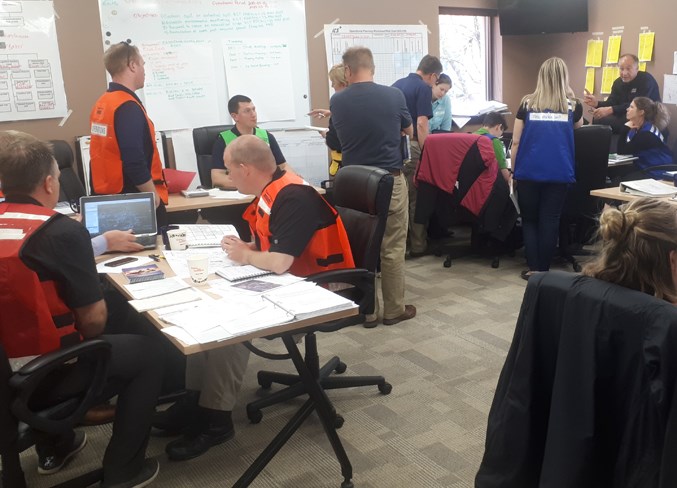About 40 first responders from across Central Alberta gathered at the fire hall Wednesday and Thursday to practise their skills via a simulated disaster.
In addition to Town of Olds employees, participants came from as far away as Stettler and Clearwater County.
The scenario was a big train derailment on the tracks near 54th Street.
At least some of the cars were carrying hazardous goods, so the scenario included evacuating nearby residents and setting up an evacuation centre for them to stay at while the problem was dealt with.
All of this was done in the fire hall. No one was actually evacuated. It was all done via phone calls and people coming in and out of the building.
The simulation was organized by Red Deer County officials in conjunction with Alberta Emergency Management Agency.
Red Deer County acting director of corporate services Ric Henderson served as one of the team leads for the central region hazard incident management team.
He said Red Deer County received a grant from the Alberta Emergency Management Agency to take the lead on organizing the event.
Henderson said this was the third time such a simulation had been held in Central Alberta and the first time the simulation had been held in Olds. He said a three-day one will likely be held in the fall but at the moment, it's uncertain where it will be held.
"What they're working through is there's teamwork developing, coming to a municipality to help out. Not to take over, but supplement the roles of managing an incident," Henderson said. "They're coming up with a plan. You have to always have a plan ahead for the next period."
Bob Ford, manager of regional field operations for the Alberta Emergency Management Agency, said back in January 2017 the agency began working on building greater capacity for municipalities in Alberta to be prepared for emergencies; hence creation of these training scenarios.
The idea is to help municipalities work with emergency crews via regional partners "to solve complex problems."
He explained that the scenarios cover various levels of complexity, from a simple motor vehicle collision to type three events like the one hosted in Olds which simulate complex disasters.
"A complex incident is going to go multiple days, lots of resources attached to it and oftentimes that's maybe five per cent of the incidents that a municipality's ever going to see, but they often outstrip an individual municipality's ability to manage them, because they are complex," Ford said.
"We provide instant command system training to municipalities but this is taking that training to a far deeper level. They're learning techniques and processes that you don't get from a standard suite of training we deliver."
Ford was pleased with how last week's event went. In fact, he said it went better than he expected.
"Central region's a very strong region. There's a bunch of good, strong EM (Emergency Management) personnel inside this region, in the municipalities in this region," Ford said. "They work well together. Strong leadership out of Red Deer County. It's been very good."
Among those participating in the simulation was Jen Lutz, community facilitator and deputy director of emergency management for the Town of Olds.
She said town officials always work on their plans for emergencies throughout the year to keep them as updated as possible.
In the scenario, her job was to help set up the reception centre for evacuees.
Lutz said she's done some emergency management training but Wednesday and Thursday's exercise was a higher level of training than she had experienced.
As part of her job in the scenario, Lutz took calls from "worried residents."
In one case, a call came from "Gertrude" who lived near the tracks and was anxious about her 10 cats. She wanted to bring them to the evacuation centre.
"So you understand we're dealing with an emergency. We're going to do our best. It's going to be looking after people first. Ten cats is a lot to transport," Lutz told Gertrude.
"But they're my babies. Like, they're people too, you know," Gertrude said.
In the end, they agreed that if Gertrude could find one or more boxes to transport the cats, emergency officials would help her get them out.
Lutz said the training provided via the simulation was well worth it.
"It makes you a lot more comfortable in case there's an emergency. If we ever had to call (in) mutual aid we'd be calling these folks," she said. "They give us expertise to help ourselves.
"We have capacity within our own organization, but if it got really big, you're going to look for other resources, so we gain relationships with people that you might be working with. Or if another county needed help we'd be sending people there."



